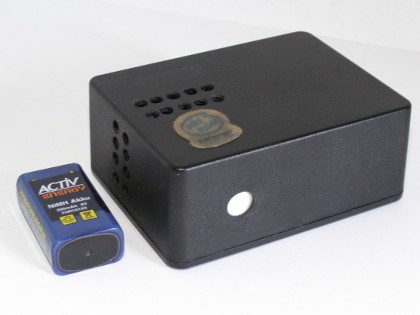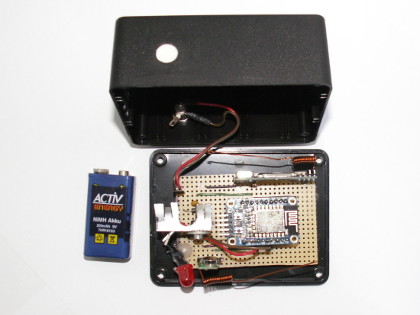puuu / Mqtt433gateway
Projects that are alternatives of or similar to Mqtt433gateway
MQTT433gateway
This Project implements a MQTT 433.92MHz radio-frequency device gateway. This is a IoT bridge to couple popular RF devices like RC power-socket switches or weather stations to internet capable devices like smartphone and tables. In this way they can be integrated into a home automation system.
The Software runs on a ESP8266 micro controller/WiFi chip and process many 433.92MHz radio-protocols themselves. The protocols are processed utilizing the ESPiLight Arduino library which is a port of the pilight 433.92MHz protocols to the Arduino platform. The aim is to transmit, receive and parse many 433.92MHz protocols directly on the device and publish the results via MQTT.
A list of supported protocols can be found in the pilight manual: https://manual.pilight.org/protocols/433.92/index.html
Installation
Firmware binary are provided under releases. If you want to build from source please have a look at Development. For the first flash you have multiple possibilities, some of them are:
- Build and flash with PlatformIO (see Development)
- Flash with esptool.py
$ esptool.py --port <serialport> write_flash 0 mqtt433gateway_<env>-<version>.bin
- Flashing the
WebUpdaterexample from Arduino (File -> Examples -> ESP8266HTTPUpdateServer) and uploading the MQTT433gateway binary via browser.
At the moment two binaries are provided:
-
mqtt433gateway_esp12e-*.bingeneric ESP8266 module with cpu clock = 80 MHz (recommend) -
mqtt433gateway_esp12e_160-*.bingeneric ESP8266 module with cpu clock = 160 MHz
The platformio.ini provides more environments, but the main
different between these are the way how they are flashed via serial
connector and how additional components (like LEDs) are
connected. Since MQTT433gateway can be fully configured by the web
frontend and provided over-the-air programming, these
binaries should be sufficient.
Hardware
The Software is primarily written for ESP8266 devices. It is tested
with an
Adafruit HUZZAH ESP8266, but
any other ESP8266 board should be fine too. The circuitry can be
found in the hardware folder. The circuitry utilizes a separate 5V
voltage regulator. This way it is possible to supply the
MQTT433gateway with up to 12V. The 434MHz transmitter is directly
connected to the power-supply input, thus it can be driven with 12V
which enhances the transmitting range. But powering with 12V also
means that the voltage regulator dissipates much power and a heat sink
is highly recommended.
For transmitting and receiving you need 434MHz-RF modules. More information can be found here:
- https://wiki.pilight.org/receivers
- https://wiki.pilight.org/senders
- https://github.com/sui77/rc-switch/wiki/List_TransmitterReceiverModules
If you are interested in a good receiving range, then I can not recommend a WRL-10532 module. I only achieved a range of about 5m with it, after changing it against a RXB6 receiver, the range increases to over 30m (including walls).
For the transmitter and receiver module you need separate antennas. 1/4 lambda (17cm) antennas are sufficient, but you may want to try coil loaded antennas.
LED status
The MQTT433gateway indicates its status by a LED:
- Connecting to WiFi/startup: Flashing at 1 Hz
- WiFiManager require WiFi configuration: Flashing at 5 Hz
- Device require configuration: Flashing at 0.5 Hz
- Normal operation: Heartbeat pulsing
- OTA Update: on during upload
Configuration
The device is fully configurable through a web browser. If you boot it for the
first time, it will create a WiFi access point (default ssid is rf434) where
you can connect to. If you type in any url in your browser, you will get
directed to the WiFi configuration of the device. You can select your network
here and fill in the credentials.
After that it will stop the access point and connect to your network. There you
can either discover it via mDNS (default is rf434.local), ask your router for
the address of the device or check the serial console output. If you type this
address in your browser, you'll see the main configuration frontend. The
default username is admin, the default password is MQTT433gateway.
Please fill here your MQTT connection details. You can also change the topics the device will subscribe and publish to. In addition, all hardware related settings, like connection pins of transmitter and receiver are configurable.
Please note: you have to change the configuration password! For security reasons the device will not start working before this password is changed.
MQTT/Automation
The MQTT433gateway communicates via MQTT, therefore a MQTT broker is needed,
e.g., Mosquitto. The topics for receiving and
transmitting can be configured with the mqttReceiveTopic and mqttSendTopic
settings. They default to rf434/recv/ and rf434/send/, respectively. It is
possible to use a common topic for multiple gateways in one network and thus to
expand the radio range.
After (re)connecting to the MQTT broker, the gateway sends the message
{"version":"<git tag or hash>","chipId":"<chipId>"} to the version
topic that is set in mqttVersionTopic as well as the message
online to the state topic that is set in mqttStateTopic. In
addition, it registered with the last will set to the message
offline for the state topic. This allows to check the status of the
MQTT433gateway, e.g. as a availability topic in Home Assistant.
MQTT subscription is done to the topic <mqttSendTopic><protocol>. The
messages to be transmitted must be a valid pilight JSON messages. The setting
mqttSendTopic should end with a /. <protocol> is the pilight protocol
name. Additionally, <protocol> can be RAW to transmit a RAW signal similar
as used with the pilight USB Nano.
Received and decoded RF signals are published in the
<mqttReceiveTopic><protocol>[/<id>] topic as pilight JSON message. To
avoid receiving errors, a message must be received at least twice
before it is published. <protocol> is the pilight protocol name and
the optional <id> will be used if the pilight JSON message contains
an id attribute.
Integration in Home Assistant
Here are some examples how to integrate the MQTT433gateway into Home Assistant.
Status of the MQTT433gateway:
binary_sensor:
- platform: mqtt
state_topic: "rf434/state"
name: "rf434"
payload_on: "online"
payload_off: "offline"
device_class: connectivity
The message of a TCM 218943 weather station sensor looks like this:
rf434/recv/tcm/108 {"id":108,"temperature":22.7,"humidity":50,"battery":1,"button":0}.
A corresponding Home Assistant configuration is:
sensor:
- platform: mqtt
state_topic: "rf434/recv/tcm/108"
unit_of_measurement: "°C"
name: "tcm_a_temp"
value_template: '{{ value_json.temperature }}'
device_class: temperature
availability_topic: "rf434/state"
- platform: mqtt
state_topic: "rf434/recv/tcm/108"
unit_of_measurement: "%"
name: "tcm_a_humidity"
value_template: '{{ value_json.humidity }}
device_class: humidity
availability_topic: "rf434/state"
binary_sensor:
- platform: mqtt
state_topic: "rf434/recv/tcm/108"
name: "tcm_a_battery"
sensor_class: power
payload_on: 0
payload_off: 1
value_template: '{{ value_json.battery }}'
device_class: battery
availability_topic: "rf434/state"
Impulse RC socket switches, like many RC socket switches with DIP switches:
switch:
- platform: mqtt
name: "impuls_24_1"
command_topic: "rf434/send/impuls"
payload_on: '{"systemcode":24,"programcode":1,"on":1}'
payload_off: '{"systemcode":24,"programcode":1,"off":1}'
availability_topic: "rf434/state"
- platform: mqtt
name: "impuls_24_2"
command_topic: "rf434/send/impuls"
payload_on: '{"systemcode":24,"programcode":2,"on":1}'
payload_off: '{"systemcode":24,"programcode":2,"off":1}'
availability_topic: "rf434/state"
- platform: mqtt
name: "impuls_24_3"
command_topic: "rf434/send/impuls"
payload_on: '{"systemcode":24,"programcode":4,"on":1}'
payload_off: '{"systemcode":24,"programcode":4,"off":1}'
availability_topic: "rf434/state"
Elro 800 based RC socket switches:
switch:
- platform: mqtt
name: "elro800_13_A"
command_topic: "rf434/send/elro_800_switch"
payload_on: '{"systemcode":13,"unitcode":1,"on":1}'
payload_off: '{"systemcode":13,"unitcode":1,"off":1}'
availability_topic: "rf434/state"
- platform: mqtt
name: "elro800_13_B"
command_topic: "rf434/send/elro_800_switch"
payload_on: '{"systemcode":13,"unitcode":2,"on":1}'
payload_off: '{"systemcode":13,"unitcode":2,"off":1}'
availability_topic: "rf434/state"
- platform: mqtt
name: "elro800_13_C"
command_topic: "rf434/send/elro_800_switch"
payload_on: '{"systemcode":13,"unitcode":4,"on":1}'
payload_off: '{"systemcode":13,"unitcode":4,"off":1}'
availability_topic: "rf434/state"
- platform: mqtt
name: "elro800_13_D"
command_topic: "rf434/send/elro_800_switch"
payload_on: '{"systemcode":13,"unitcode":8,"on":1}'
payload_off: '{"systemcode":13,"unitcode":8,"off":1}'
availability_topic: "rf434/state"
Quigg GT9000 based RC socket switches, e.g., Tevion GT-9000, SilverCrest 91210 or Intertek Unitec 48110:
switch:
- platform: mqtt
name: "gt9000_590715_0"
command_topic: "rf434/send/quigg_gt9000"
payload_on: '{"id":590715,"unit":0,"on":1}'
payload_off: '{"id":590715,"unit":0,"off":1}'
availability_topic: "rf434/state"
- platform: mqtt
name: "gt9000_590715_2"
command_topic: "rf434/send/quigg_gt9000"
payload_on: '{"id":590715,"unit":2,"on":1}'
payload_off: '{"id":590715,"unit":2,"off":1}'
availability_topic: "rf434/state"
- platform: mqtt
name: "gt9000_590715_3"
command_topic: "rf434/send/quigg_gt9000"
payload_on: '{"id":590715,"unit":3,"on":1}'
payload_off: '{"id":590715,"unit":3,"off":1}'
availability_topic: "rf434/state"
OTA Update
Updates of the MQTT433gateway can be preformed by OTA (Over-the-air
programming) via the web frontend. To do this, you need the binary
file that can be found under
releases or, if you
build with PlatformIO, at <BUILD_DIR>/firmware.bin,
e.g. .pio/build/esp12e/firmware.bin.
Debugging/RF-protocol analyzing
The MQTT433gateway has a powerful logging system based on
ArduinoSimpleLogging. Messages
for different log levels can be logged to serial interface, websocket (web
frontend) and syslog server. The configuration can be done via web frontend.
The log messages could be very helpful for debugging. In addition, RF-protocol
analyzing can be enabled with the protocolRaw debug flag.
Protocol limitation
If you have the situation that there is a lot of noise in the air and/or your device matches multiple protocols, you can limit the available protocols. This is easily possible with via the web frontend.
Development
The software is using the PlatformIO ecosystem. See their install instructions or get their IDE to get the software. More information can be found in their documentation.
-
Open a terminal and go to the MQTT433Gateway project folder.
-
After that, decide for which board to create the firmware and give this as
--environmentto the platformioruncommand:$ platformio run --environment <board>
The available boards are defined in
platformio.ini. Currently, this are-
esp12efor ESP8266-12e/f models, -
esp12e_160for ESP8266-12e/f models with cpu clock set to 160MHz, -
nodemcufor NodeMCU 0.9 boards, -
nodemcuv2for NodeMCU 1.0 boards, -
d1_minifor D1 Mini boards, -
huzzahfor the Huzzah boards.
-
-
To flash the firmware to the board, connect the board to the PC via USB or a serial adapter. Make sure, it is the only device currently connected, as otherwise you might flash the wrong unit accidentally. Some boards need to be set manually into a programming mode, please check the manual of the board to get more details about how to do that. The
platformio runhas the upload target to initialize flashing:$ platformio run --environment <board> --target upload
this will try to autodetect the serial port. If this is not successful, try
$ platformio run --environment <board> --target upload --upload-port <path-to-serial-port>
Older versions of MQTT433gateway were developed with the Arduino
IDE. You can find the old sources in the departed
arduino branch.
Contributions
If you find any bug, please feel free to fill an issue. Also, pull request are welcome. More information can be found in the contributing guide.
Acknowledgement
Big thanks goes to the pilight community, which implemented all the 434MHz protocols. If you want to integrate more protocols, please contribute directly to pilight.
Many thanks goes to @janLo, who developed the web configuration interface.


